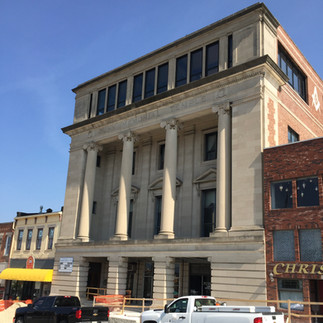Lodge, Lodge, Everywhere a Lodge
- rethinkphil
- May 24, 2021
- 3 min read

As Beth and I wandered all over the state of Indiana, we began noticing the fraternal lodge buildings that exist in our towns. They come in all shapes and sizes. Some use the upper story of a building erected in the late 19th or early 20th century. Some are magnificent structures in big cities and small towns. Apparently it wasn't enough for a community to be satisfied with one group in town, not even in a smaller community. I grew up not far from Colfax, Indiana (current population - 691) in Clinton County and it even has a 'triple play,' three different lodges within a two-block area of a town with peak population of 800.
I am not here to share the story of these organizations and their creeds or origins. I just find their buildings fascinating. And, I wonder how a small community could support 2 or 3 groups? Were there overlapping members? Some of the fraternal societies are old and established, and more well-known than others. In an entry on the Knights of Pythias in Wikipedia, it states, "By the end of the so-called 'Golden Age of Fraternalism' in the early 1920s, the order had nearly a million members. By 1979, however, this number had declined to fewer than 200,000."
When driving through these towns, I am drawn to look to the upper reaches of a building's facade searching for letters, dates and symbols. Whether it's the lodge in Beard, Indiana (4 houses and a lodge) or the ornate Murat Shrine and magnificent Scottish Rite Cathedral in downtown Indianapolis, they signify belonging. I was aware of the Masonic Order and IOOF (Independent Order of Oddfellows), but over time I learned of the Knights of Pythias 'Castles' (KofP), Knights of the Maccabees (KOTM), and Improved Order of Red Men (IORM). Many of these were early groups and were later joined by the American Legion, VFW, Eagles, Moose, Elks and many many others. Look up 'fraternal organizations' on Wikipedia to learn more.
In the early 20th Century, another movement emerged to engage people in business and community - civic organizations. Rotary International was founded in 1905 (of which I am a member), Lions, Kiwanis, Optimist, Sertoma, Zonta, and other community groups were also established. Robert Greenleaf, the founder of the modern servant leadership movement, pointed out that in high school history classes we all study the societal and global changes brought about by the Industrial Revolution. He challenged us to explore the mostly ignored emergence of an Institutional Revolution that followed. Will 20th Century organizations thrive or wither in the 21st Century? What organizations will emerge to create connections that we, as humans, require for mental, emotional, and spiritual health? What physical or digital forms will they take? Difficult questions.
In the meantime, we must address the continued use and reuse of structures in our cities and towns. Some of these buildings are beautiful and some are incredibly nondescript. Some are large and some are small. I even found a building in which two organizations have 'nameplates' on a shared building. As chapters disappear, they are dropped from the organizations' registries, but the buildings remain. I recently had a conversation with a gentleman from The Red Men Museum and Library in Waco, Texas. I am aware of three IORM lodges in Indiana, while he said that, at its peak, there were more than 600 Improved Order of Red Men lodges in Indiana alone!
So I am fascinated by the lodges' architecture. Carnegie Libraries continue to be used and reused because they are beautiful structures. What do these building mean to our communities? Can we use them to sustain or rekindle the spark of connection within our cities, towns, villages, and rural communities? I am curious as to how and why connection within communities has changed over time. While I want to talk with people about these groups, my greater desire is to learn what it means to belong.
Here are just a few lodge pictures to whet your appetite to get out and wander.
Colfax, Indiana's 'triple play.' The white IOOF Hall sits side-by-side with the red brick Knights of Pythias Castle, and one block away sits the former Masonic Lodge. The latter building is where I opened my first bank account.
Here's a variety of Indiana's Masonic Lodges, still in use. (L to R) Eckerty, Brownsville, Dunn Memorial Temple in Bedford.
More Indiana Lodges - 'KOTM' (Knights of the Maccabees) on the nameplate of a building in Denver. 'Cherokee Tribe No. 96 I.O.R.M' (Improved Order of Red Men) in Noblesville. The "double lodge" in Paragon erected in 1898 (plate between center windows) with two nameplates between the three windows - 'Paragon Lodge, #406 I.O.O.F., 1872' (left) and 'Morgan Lodge, No.431 K. of P, 1895' (right).
So slow down when you drive and look around. Chances are you'll find a lodge, they're everywhere.























Comments